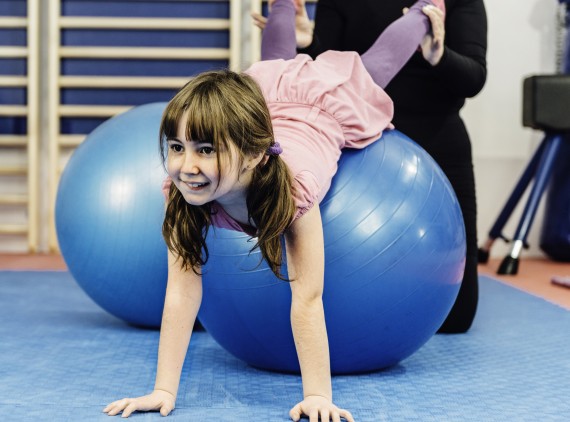Irregular toileting habits can greatly impact a child’s quality of life and affect the entire family. If the issue isn’t treated and resolved, it can continue into adulthood and lead to other health problems as they age.
If your child is unable to control normal urine or stool function, they may benefit from pelvic floor physical therapy. Pelvic muscle therapy also can help reduce pelvic pain.
What is pelvic floor physical therapy?
Pelvic floor physical therapy (PT) is a specialized physical rehabilitation service. At a children’s hospital, the physical therapists are trained to work with kids who have pelvic floor challenges. Kids face different issues than adults, so finding a pediatric pelvic floor program is key to your child’s success.
Pelvic floor therapy focuses on the muscles and connective tissue between the hips at the base of the pelvis. These muscles play an important role in:
- Bladder and bowel control
- Core strength
- Posture
- Overall pelvic health
“When the muscles that support the pelvis are out of balance – either too tight, too weak or not coordinating in the right way – kids can’t use the toilet as they should,” said Kendall Spiker, PT, DPT, who leads the Pelvic Floor Therapy program at Phoenix Children’s. “If this describes your child, our pelvic floor PT program can help. Pelvic floor therapy teaches kids how to strengthen, contract and relax these muscles.”
What conditions can pelvic floor PT help treat?
Pediatric pelvic floor therapists are specifically trained to help kids with these conditions:
- Urinary problems, such as having daytime accidents, wetting the bed (enuresis), emptying their bladder completely, and controlling urgency and how often they urinate
- Bowel issues, including being constipated, withholding stool or leaking stool (encopresis)
- Pain in the abdominal or pelvic area
These conditions can cause a lot of stress, embarrassment and low self-esteem for a kid. It’s also stressful for the family, particularly those caring for the child, when it impacts daily living and the ability to enjoy social events.
What are the benefits of pelvic floor PT?
Since pelvic floor challenges differ for each child, the specific goals of therapy may differ as well. Most kids gain these benefits from pelvic muscle therapy:
- Better bladder and bowel control
- Education for the patient and family
- Improved confidence and quality of life
- Improved core strength
- Use of the diaphragm to breathe correctly
What happens during pelvic muscle therapy?
At your child’s first pelvic floor therapy appointment, the therapist will spend time talking with you and your child. The therapists want to make sure they fully understand your child’s unique needs.
This careful evaluation may include evaluating core strength, balance, posture and breathing patterns. The physical therapist also may perform an external pelvic exam, if needed and agreed to by you and your child. All of this information will help the therapist develop the best patient care plan for your child.
Also during the first visit, you and your child will learn home exercises and other strategies to practice between therapy sessions. For some kids, one therapy session is all they need. Most others need follow-up sessions.
Each session will be tailored to your child’s goals. Most pelvic floor sessions include:
- Learning breathing exercises to support pelvic function
- Building core strength
- Improving posture
- Tightening (contracting) and relaxing pelvic floor muscles
- Developing a program for home exercises
Biofeedback offers real-time insight
During follow-up therapy sessions, our therapists may use biofeedback to help your child. Biofeedback uses small stickers (electrodes) placed on the skin near the pelvic and glute muscles. This tool lets your child see in real time how they are using those muscles. Biofeedback helps kids learn how to correctly relax and tighten their pelvic floor muscles.
What should I expect after my child receives pelvic floor therapy?
“During therapy, kids and families learn to adjust their daily habits. This may include changing bathroom routines and using the best posture when sitting on the toilet,” Kendall said. “We teach families a total body approach, not only how to use their pelvic floor muscles well, but also the importance of drinking enough water, following daily toileting habits and eating foods that promote healthy bowel habits.”
At Phoenix Children’s, our Pelvic Floor Therapy program teaches your child home exercises to practice on their own. We give your family strategies that will help your child succeed. Many kids see improvement simply by raising their awareness of the muscles that control bowel and bladder function.
As someone caring for the child, you can share in the joy they feel after building confidence and independence when toileting.
Is my child old enough for pelvic floor PT?
Pelvic floor therapy is most effective when the child has the cognitive skills needed to participate in exercises and implement daily toileting habits. Typically, children over the age of 5 years have enough awareness to fully benefit from pelvic floor therapy.
Families with younger children also benefit from a pelvic floor PT session that offers education, parental guidance and daily strategies to follow. Kids under 5 may not be right for ongoing sessions, but they can return to the program when old enough to engage in the process.
How do I schedule my child for pelvic floor physical therapy?
If your child has trouble controlling their bladder or bowels, often gets urinary tract infections (UTIs) or has any of the challenges mentioned above, consider trying pelvic floor therapy. The first step is to get a referral from your child’s pediatrician, urologist or gastroenterologist.
Phoenix Children’s offers Pelvic Floor Therapy programs at our outpatient clinics in downtown Phoenix and in Gilbert. Learn more about the Phoenix Children’s Pelvic Floor Therapy program. If you have any questions, call us at 602-933-0980.

